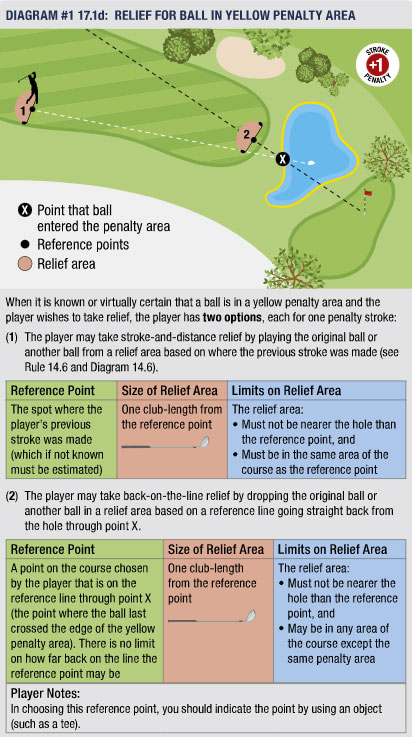

USGA RULES
This section is intended to make sure that our members are all aware of, and playing to the same set of rules. The Boeing Retirees Golf League follows the USGA Rules of Golf, with minor modifications. These include Winter Rules that are unique to BRGL, Ready Golf, and the 2019 stroke-and-distance Local Rule for Out-of-Bounds (OB) or Lost Ball.It is to your advantage to become familiar with your options for the Local Rule (OB or Lost Ball). The USGA has some very helpful diagrams showing representative “relief areas” and how they can be used. For example, you have the option of dropping a ball within the first two club lengths of the nearest fairway, or elsewhere along a generous arc that can help you avoid trees. Please become familiar with your Local Rule options.
It is strongly recommended that all members be aware of the other 2019 changes, which apply to USGA, not just us. Changes include a new height for dropping a ball, new terms for “through the green” and “water hazard”, and leniency on a number of issues, such as impediments in a bunker, just to name just a few. Please browse through the 2019 USGA Rule Changes to familiarize yourself with them.
Lastly, the comprehensive USGA Rules of Golf are available to read through for any other questions. This link shows all the USGA Rules and Interpretations of golf in a very easy-to-read, organized fashion.
BRGL "LOCAL RULES"
- The only unique BRGL Local Rule is that we play "Winter Rules" all season long. You may mark, pick up, and clean your ball, then place it within 12" of its original location, but not nearer the green/pin. You may not use Winter Rules when in a hazard, but the BRGL does not restrict its use elsewhere (e.g. next to a boundary fence, tree, stump, etc). Because we are a retiree league, you are allowed to improve your lie by using your club head, but again, no nearer the hole.
- There will be NO "GIMMES" in our BRGL league play. The distance of what constitutes a "gimme" is open to individual interpretation and has long been a point of confusion and consternation among our members. The solution to that is to just have the player tap it in.
- Play “Ready Golf”. Do not rely on the honors system to determine whose shot it is, especially if this will slow the Pace of Play.
- Fewest Putts. Until your first shot from the surface of the green (not fringe) nothing is considered a putt. That shot and everything after is a considered a putt regardless of whether the next shot is from off the green or which club is used. If a ball is touching the green, even if most of it is in the fringe, it is still considered to be on the green.
- Take advantage of the 2019 USGA Local Rule for Out of Bounds and Lost Ball, which is also designed to speed up play. DO NOT return to the spot of the previous stroke (e.g. the tee). If you suspect that the ball you just hit may be lost or OB, you may still play a provisional ball, but it is not required. If you do play a provisional ball, you cannot later invoke the Local Rule if you find your first ball OB; you must play the provisional.
You incur a TWO STROKE penalty when using the Local Rule. For example, if you hit your tee shot out of bounds, you may tee up another ball, hitting three. This is the old stroke-and-distance relief rule, still in effect, but you may also just walk up to the “relief area” defined in the Local Rule (even if you know your ball is out of bounds, or certainly lost). Drop another ball in the specified “relief area” and add two penalty strokes. You are lying three (hitting four), just as if you had taken stroke-and-distance relief, and your second ball landed there. One advantage of invoking the Local Rule for a ball known to be OB or Lost is to eliminate the chance of hitting another errant shot, or shots, from that same location.
Lost Ball - you get 3 minutes to look for a lost ball, if you choose to. Time spent looking for a lost ball should always factor in how well your group is keeping up with the group ahead.
Penalty Areas - when your ball lands in a penalty area (pond, lake, creek) there is NO Local Rule option. If unsure of where your ball landed, hitting a provisional ball may be a good idea. There might also be a designated Drop Zone. You may play the ball where it lies, if that is feasible. Another option is “back on the line” relief. The “line” is NOT the path taken by your ball; it is an imaginary line drawn from where your ball entered the penalty area, to the flagstick on the green. You may drop back (no closer the hole) on that line, if circumstances allow. A lateral (red-staked, or red-painted) penalty area has an additional option for relief. You may drop within two club lengths of the point of entry, no closer to the hole. Use the longest club in your bag, other than your putter.
Helpful diagrams and descriptions are also available for Rule 17 - Penalty Areas - select Rule 17 in right menu on that page to see all the diagrams. For example:

